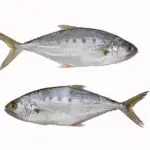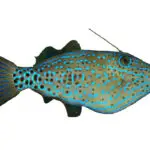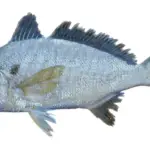Mullet are mostly viewed as a saltwater species, both as a sought-after food fish and as very effective bait for fisherman…
But can mullet live in freshwater? Are they even found in freshwater?
In this article, I’ll answer all of those questions and more… let’s dive in!
Table of Contents
- Can Mullet Live In Freshwater?
- Are Mullet Considered A Saltwater Or Freshwater Species?
- How To Catch Freshwater Mullet
- Can Mullet Live In Freshwater Ponds?
- Are Freshwater Mullet Good To Eat?
- Can You Keep Mullet In A Freshwater Fish Tank?
- Related Posts
Can Mullet Live In Freshwater?
Mullet can and do live in freshwater. They are a very hardy species that moves freely between salt, brackish, and freshwater environments. Along coastal areas, it’s not uncommon to find mullet miles up freshwater streams and brackish creeks.
Mullet are not only are they common in shallow ocean and coastal waters, but in freshwater rivers, creeks, estuaries, and streams.
Because they can adjust from salt to brackish to freshwater, mullet are referred to as a euryhaline species.

Some people think of mullet as a purely saltwater species, but this confusion is caused mostly by the misnaming of a few purely saltwater fish as mullets when they are actually members of other families.
A primary culprit is the whiting, which is commonly referred to as the sea mullet or Virginia mullet but is a member of the croaker family.
Because they can adjust to freshwater, mullet can often be found far up freshwater rivers and streams, sometimes miles away from the coastline!
Are Mullet Considered A Saltwater Or Freshwater Species?
Not only can mullet live in freshwater, but they can live almost their entire life in freshwater.
However, mullet don’t naturally reproduce in freshwater. There have been some attempts to make them spawn in freshwater hatcheries, with only limited success.
In the fall and winter, mullet migrate into saltwater spawning grounds offshore. The eggs hatch there, and as the hatchlings grow, they move back to shallower saltwater, as well as estuaries and freshwater rivers and streams.
When it comes time to spawn, these mullet will head back out to the ocean spawning grounds again.
Because their spawning ground is salt water, they’re considered a saltwater species even though they are equally comfortable in freshwater.
How To Catch Freshwater Mullet
The same tactics used to catch saltwater mullet can be used to catch freshwater mullet. You can use a cast net, hook and line, lures and even small presentation baits like sabiki rigs or flies.
You May Also Like: Can You Catch Mullet On A Sabiki Rig?
Always check the fishing regulations in your area to determine legal methods of take for mullet. For example, some states do not allow you to cast net mullet in freshwater.
In my experience freshwater mullet tend to be a little more ‘spookish’ than saltwater mullet. Small freshwater creeks or narrow rivers can make it challenging to sneak up on mullet without being seen.
In my area, there is a small freshwater canal behind my house that connects with the Indian River Lagoon. I see mullet it in all the time, and the easiest way I have found to catch them is to setup just on the other side of a small bridge.
When the mullet swim under the bridge, they cannot see me and they feel safe. When they pop out the other side, I’m ready with my cast net, or already have my bait in the water.
Use the terrain, and structure to your advantage. Sometimes an elevated dock, bridge, or log makes all the difference.
Can Mullet Live In Freshwater Ponds?
Mullet can and do live in freshwater ponds. In fact, the largest mullet on record came from a freshwater pond in Texas!
There are records going back to Roman times of mullet being raised for food in inland ponds.
This goes back even farther in India and Asia. In India, Italy, and Egypt, mullet are farmed in ponds to this day, still using traditional methods.
Mullet farming for food is common worldwide, but not in North America.
In some coastal areas, it’s a fairly common practice to throw a batch of finger mullet into ponds, so many ponds in these areas have mullet.
Here in Florida I know people that stock there ponds with largemouth bass and then feed them finger mullet!
Ponds that haven’t been stocked have also been found with schools of mullet! Since they reproduce in saltwater, these fish probably washed into the ponds from nearby rivers when they flooded.
How To Stock A Freshwater Mullet Pond
If you’re tired of going to the bait shop or going out and catching finger mullet every time you want to go fishing, you can start your own bait pond for mullet.
You could also eat mullet from your pond, but some people find that freshwater mullet have a stronger fish flavor than ones caught in saltwater. Most commercial mullet farms add some salinity to the water for this reason.
The first thing you’re going to need to do is to get some small mullet to put in your pond. Even the professional operations mostly start with wild hatchlings, because they’re so plentiful and hatchery spawning is not that economical or effective.
You should get your stock from the freshest water you can. While mullet can adjust to different salinity levels, going suddenly from salt to fresh water with no transition is highly stressful, and mullet don’t survive stress well.
Bait shop mullet aren’t your best bet. They’re often kept in hyper-oxygenated water that’s been chemically treated and are stressed and not very healthy.
Try catching your own mullet on hook and line or with a cast net.
Then put your stockfish into a holding tank filled with water from wherever you caught them. This tank is going to need to have aeration and filtration because mullet have a high oxygen need and produce a lot of waste.
About four times a day, you should remove some water from the tank and replace it with water from the pond.
This will allow the fish to naturally acclimate to not only the lack of salinity but to any other chemical variations in the water.
Once the water in the tank is mostly pond water, you should be able to transfer them to your pond with little or no die-off from shock.
You don’t need to worry about feeding your mullet. Mullet are filter feeders and in freshwater mostly eat on algae and other plant particles. These should be present in any pond that isn’t brand new.
Are Freshwater Mullet Good To Eat?
Freshwater mullet are not as tasty as their saltwater equivalents. The water clarity and mud associated with freshwater ponds and creeks tend to give mullet more of a fishy flavor, than those caught in saltwater or brackish environments.
Can You Keep Mullet In A Freshwater Fish Tank?
Small mullet are fairly easy to keep alive in a fish tank. If you don’t want to go to the trouble of setting up a pond, a fish tank is a good way to keep bait on hand.
Unlike a tropical tank, you won’t need a heater for mullet; room temperature is just fine. Mullet love to jump, so you’ll also need a good lid!
You’ll need proper aeration and filtration, just like any other fish tank. Mullet need high oxygen levels in the water so a good bubbler is a must.
Since mullet excrete high amounts of protein and uric acid, you’ll want both a protein skimmer attached to a powerhead and a filter with floss for particles and charcoal for chemical filtration.
A water change every two weeks or so is a must to keep nitrogen levels in check. You should remove around a quarter of the water in the tank at each change.
When you first fill the tank, fill it with water from where you caught your mullet. Start with just one or two fish for a couple of months, until the tank can develop nitrogen-eating bacteria.
Once that’s happened, the rule of thumb is one inch of fish per gallon of water.
Mullet will thrive in your tank, but they grow fast and are a fairly big fish. Unless you have a truly enormous tank (over 150 gallons), you will have to change them out for new ones when the old ones get too big.
You May Also Like: Will Catfish Eat Mullet?

Growing up in Florida, I’ve been surrounded by saltwater my entire life…and I love sharing my passion with others.
To learn more about why I started Saltwater Mecca, visit the ABOUT page.
Thank you for reading this article. Browse around & have some fun!





